We Put a Lamborghini Miura in a Wind Tunnel to See How Far Supercar Aero Has Come
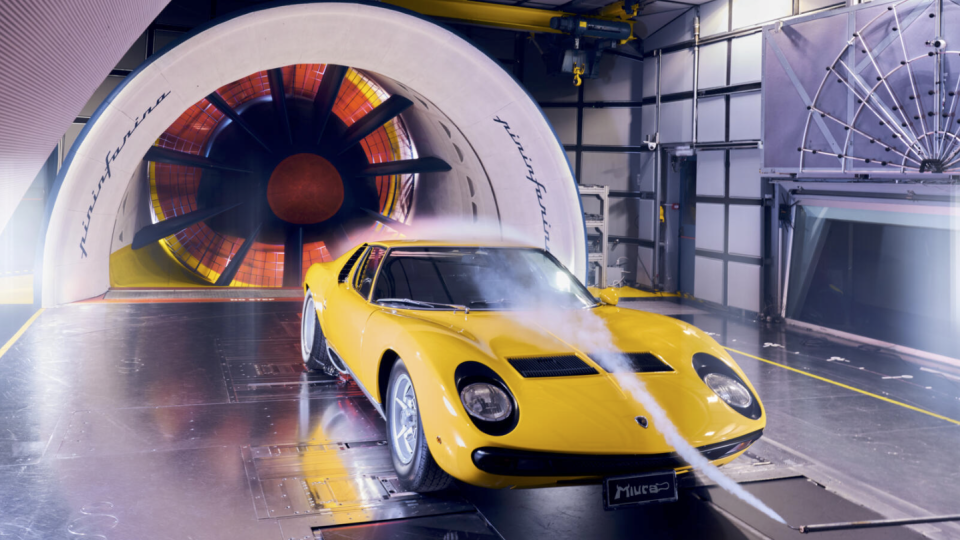
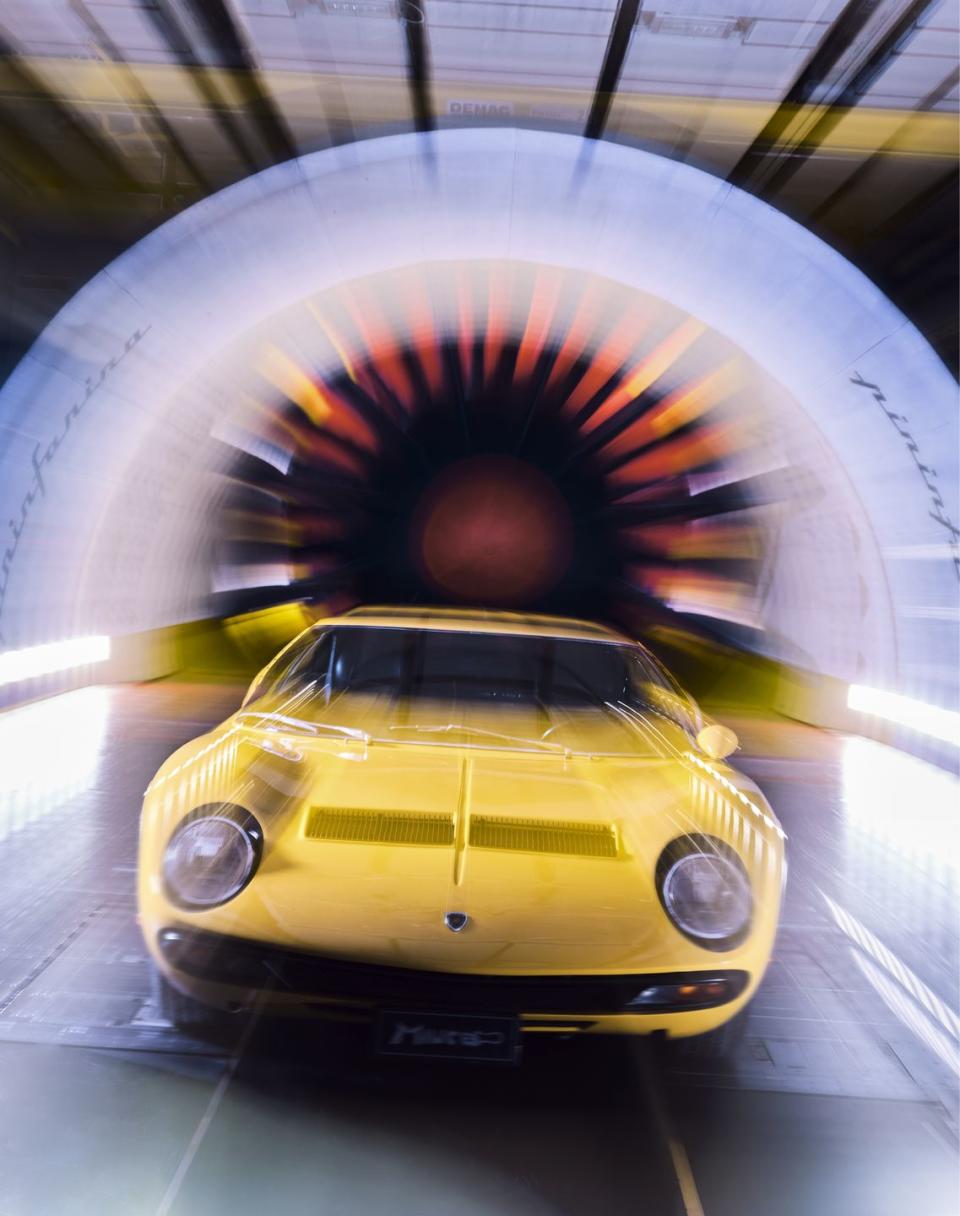
The Winds of Change Blew Through Sant’agata Bolognese in 1965
Lamborghini was in its formative years. Gorgeous 350 GTs—conceived and realized to spite Enzo Ferrari in the Old Man’s favored front-engine V-12 configuration—were birthed in the chaotic factory, the sounds of hammering and the fizz and crackle of welding torches often subsumed by completed GTs being coaxed into life. The rich noise was already echoing far and wide. But soon this tiny operation and its naive and fearless young engineering team would shock the world and inspire a new breed of high-performance mid-engine road cars. They called their radical wonder Miura. The people would come to bestow upon it a different title: supercar.
This story originally appeared in Volume 21 of Road & Track.
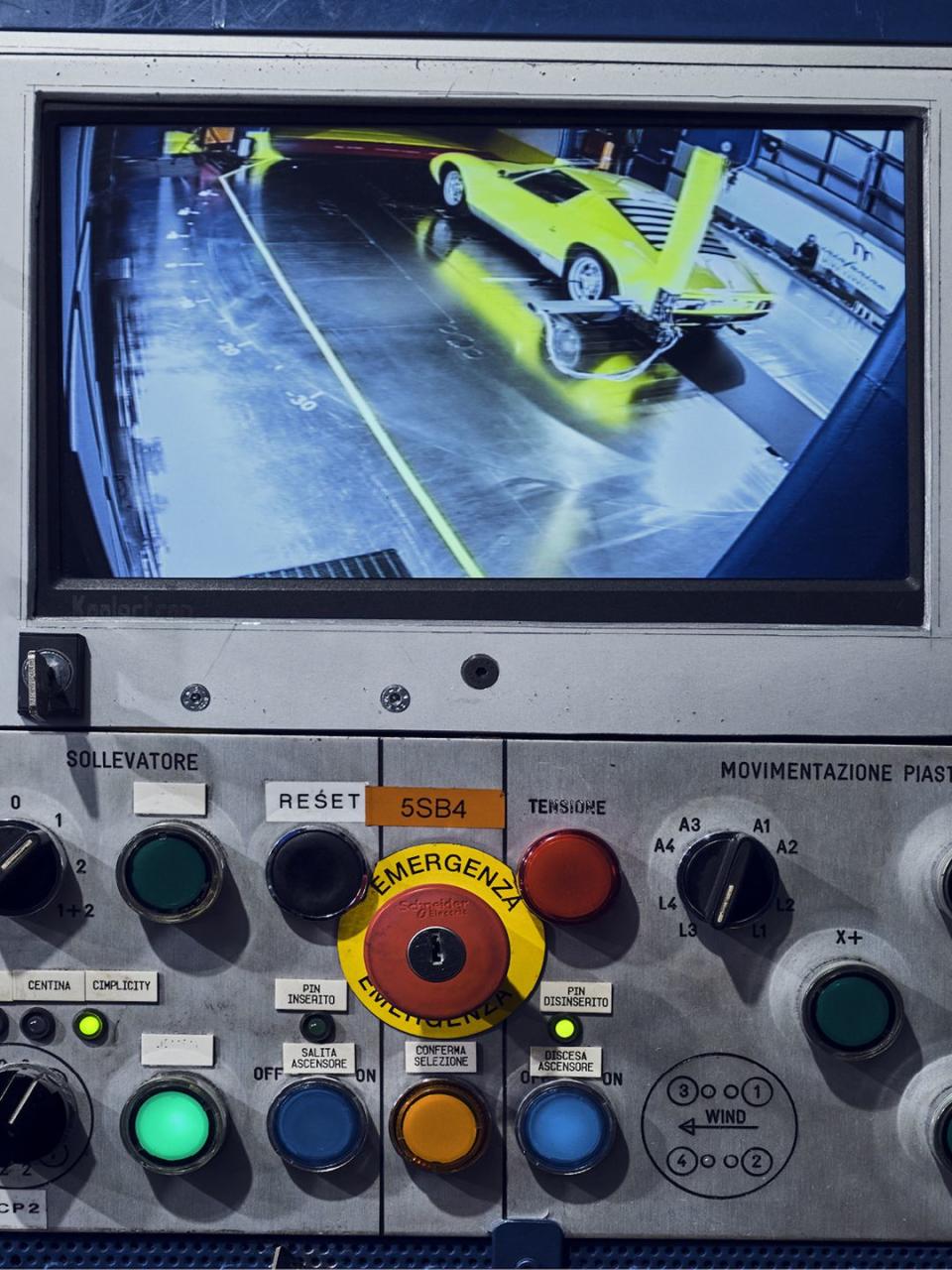
The as-yet-unnamed Miura’s rolling chassis, developed by Giampaolo Dallara and cradling a transverse Giotto Bizzarrini–designed V-12, debuted at Salone dell’Automobile di Torino in November 1965. Dallara was on the cusp of his 29th birthday. Bizzarrini, who’d developed the Ferrari 250 GTO, was the veteran of the group but still just 39. That chassis was compact, ingenious, and deeply exotic, as it sat on Borrani wire wheels covered in Pirelli Cinturato HS rubber and had ceramic-coated exhausts jutting out of four exits. In ’66, clothed in stunningly beautiful lines penned by 27-year-old Marcello Gandini for Bertone, the Miura arrived at the Geneva Auto Salon. Hysteria ensued.
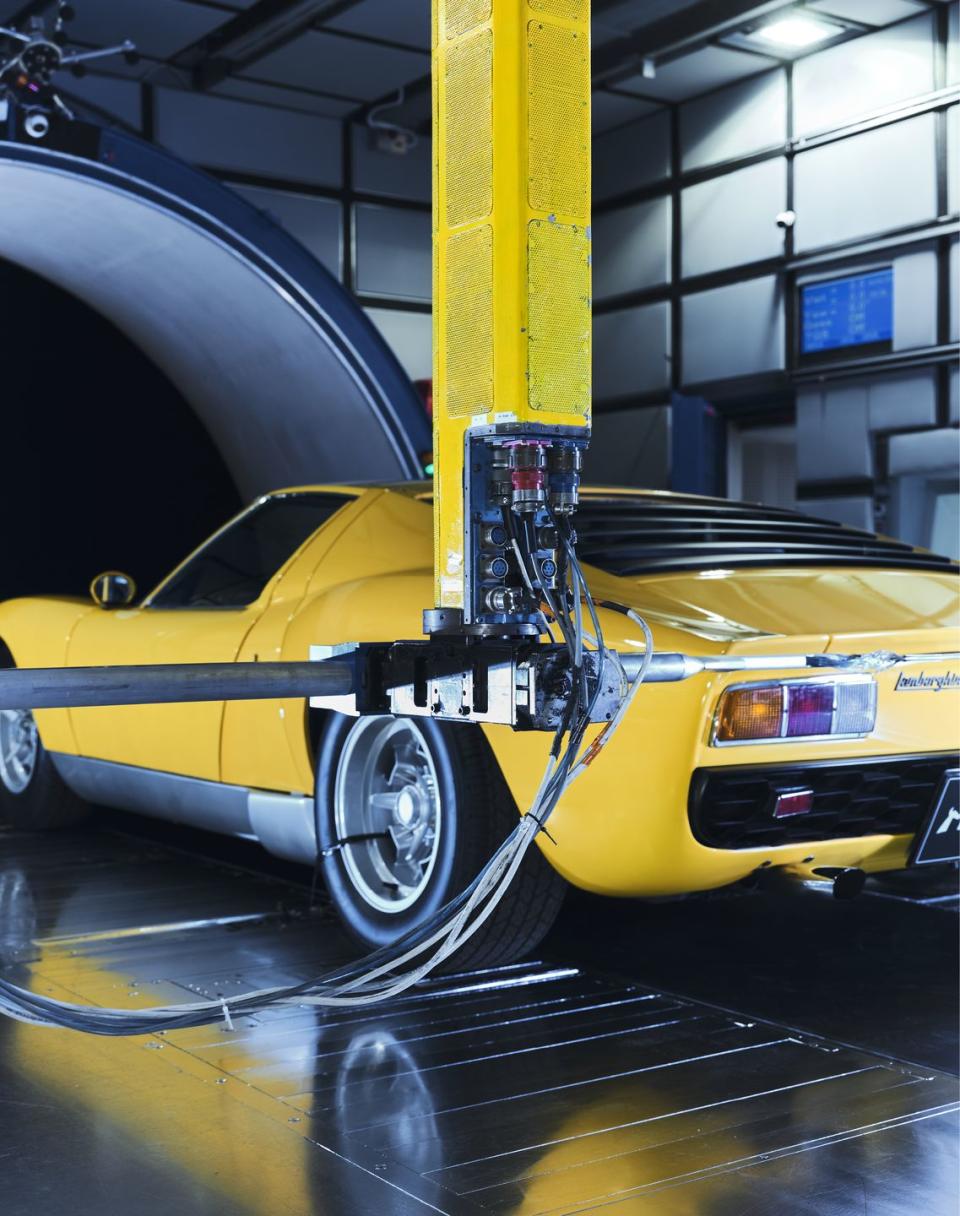
Nearly 60 years later, Gandini’s masterpiece still has the power to remove the intellect of grown adults and reduce them to hunched figures making odd groans. There’s a language barrier between myself and the staff at Pininfarina S.p.A.’s wind tunnel, but our mutual appreciation for the finest work ever to emerge from their greatest rival design house is crystal clear. It is truly spectacular to behold.
However, today isn’t about appreciation but rather myth and legend—perhaps reinforcing them, maybe exploding them with data. It’s about revealing the secrets of the Miura’s shape in a purely scientific sense. As far as Lamborghini knows, the world’s first supercar has never been in a wind tunnel. Ever. It was born when aerodynamics were determined by trial and error, beauty took priority, and pen strokes were translated into clay and metal without a computer in sight. The contrast between this evocative but sometimes calamitous approach could hardly be more stark with today’s practices. Even front-wheel-drive hot hatches now burst onto the scene with peak-downforce figures. Supercars? They are sculpted on computational fluid dynamics (CFD) programs from day one. Nothing is left to chance.
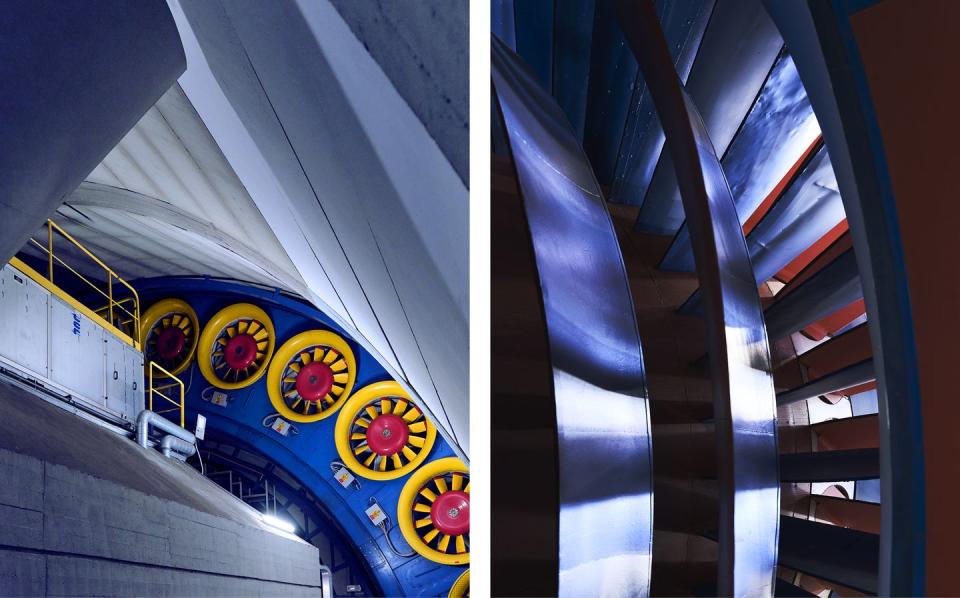
Here, in Pininfarina S.p.A.’s wind tunnel—which, remarkably, celebrated its 50th birthday in 2022—we’ll see that play out live, first with the Miura and then the Pininfarina Battista Anniversario, an EV hypercar boasting almost five times the power and designed and developed here for Automobili Pininfarina. (Yes, the legendary engineering and design house is a completely different entity from the new car company. Confusing, but true.) It’s an unlikely pairing, but funnily enough, the Anniversario’s $2.4 million asking price is probably pretty similar to what you’d pay for an immaculate Miura SV just like this one.
Chassis number 5092 is one of the last SVs of the 150 produced, and it was delivered to the Paris distributor in early 1973. Like all SVs, it is much changed from the standard P400, with a stiffer chassis, more power, wider rear wheel arches to accommodate a five-inch-wider rear track, bigger air intakes, and a longer and lower hood. Even without the aid of a wind tunnel, the team hoped to reduce the notorious “light” feeling at high speed. Tales of cars taking off over 160 mph had become folklore. Road & Track published its road test of the original P400 in May 1968 and wasn’t quite so sensationalist. The brave, perhaps foolhardy editors reached 167.2 mph with the air filters removed and found the car to feel very light and susceptible to crosswinds above 130 mph. Even so, they concluded, “the car feels as if it should be driven at least 100 mph out on the road.”
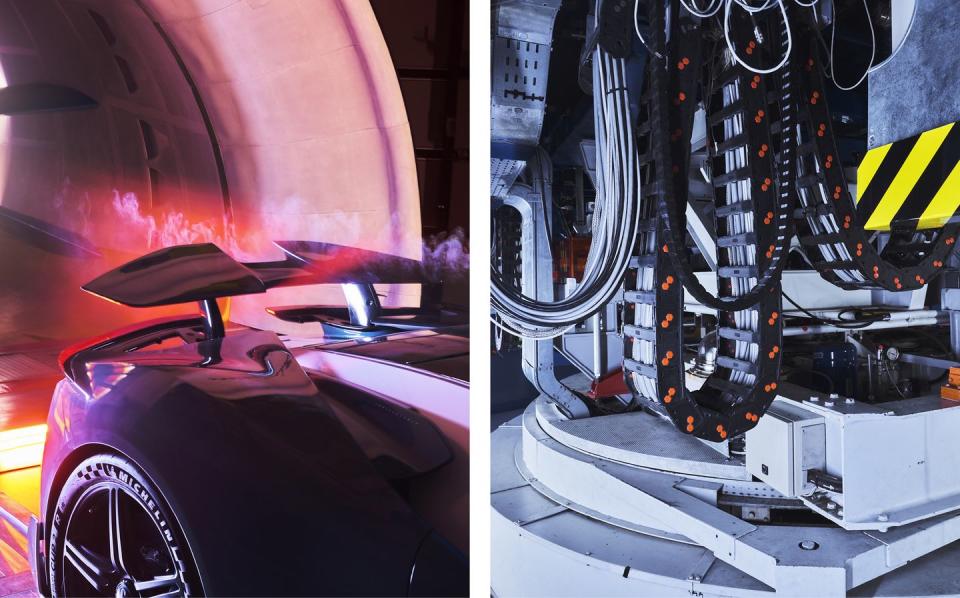
Oh, how I’d love to concur. But the Miura’s wheels won’t turn under their own power today. Nor will we spin them for these tests. However, the belt beneath the Miura and Battista will move in conjunction with wind speed and act as the road. The Pininfarina engineers will measure drag, lift, and downforce at wind speeds starting at 62 mph and building in regular intervals to 87 mph. The tests will be repeated at 5-degree yaw angles in either direction to see whether the center of pressure and loads change in corners. For the Miura, they will repeat the tests with the headlights raised to see just how disastrous the pop-up design is for aerodynamic efficiency.
There’s a real buzz in the control room as the fan starts and the floor hisses beneath the Miura. Although this facility has been continuously upgraded over the years, there’s a sort of Cold War nuclear-submarine vibe. You enter the room from below, pushing through heavy metal doors to break the air seal, then past the huge chains and mechanics of the tunnel itself. It could almost be a test day back in the Seventies to validate the SV’s modifications and corroborate the seat-of-the-pants findings of test driver Bob Wallace. Gradually, the pace picks up, and the results populate a spreadsheet.

First, it’s important to note that all drag coefficients are independent of frontal area, density, and velocity. This allows Pininfarina S.p.A. to evaluate the aerodynamic properties of a shape rather than an object. For example, a motorbike has a higher drag coefficient than a semi truck. However, the drag force of the semi is higher due to its scale. For reference, the lowest drag coefficient for any road car on sale today is the Lucid Air at 0.20; the streamliner hypercar McLaren Speedtail’s is 0.28, and a BMW X5 xDrive45e’s is 0.32.
The Miura shows a pretty consistent 0.38 Cd across its speed range. Although that sounds high compared with a super-slippery EV, it’s broadly in line with a new supercar. Furthermore, as the Miura is tiny by today’s standards and incredibly low, the frontal area is small (1.69 square meters) and creates less drag force than a modern car with a similar drag coefficient. So far, so good.
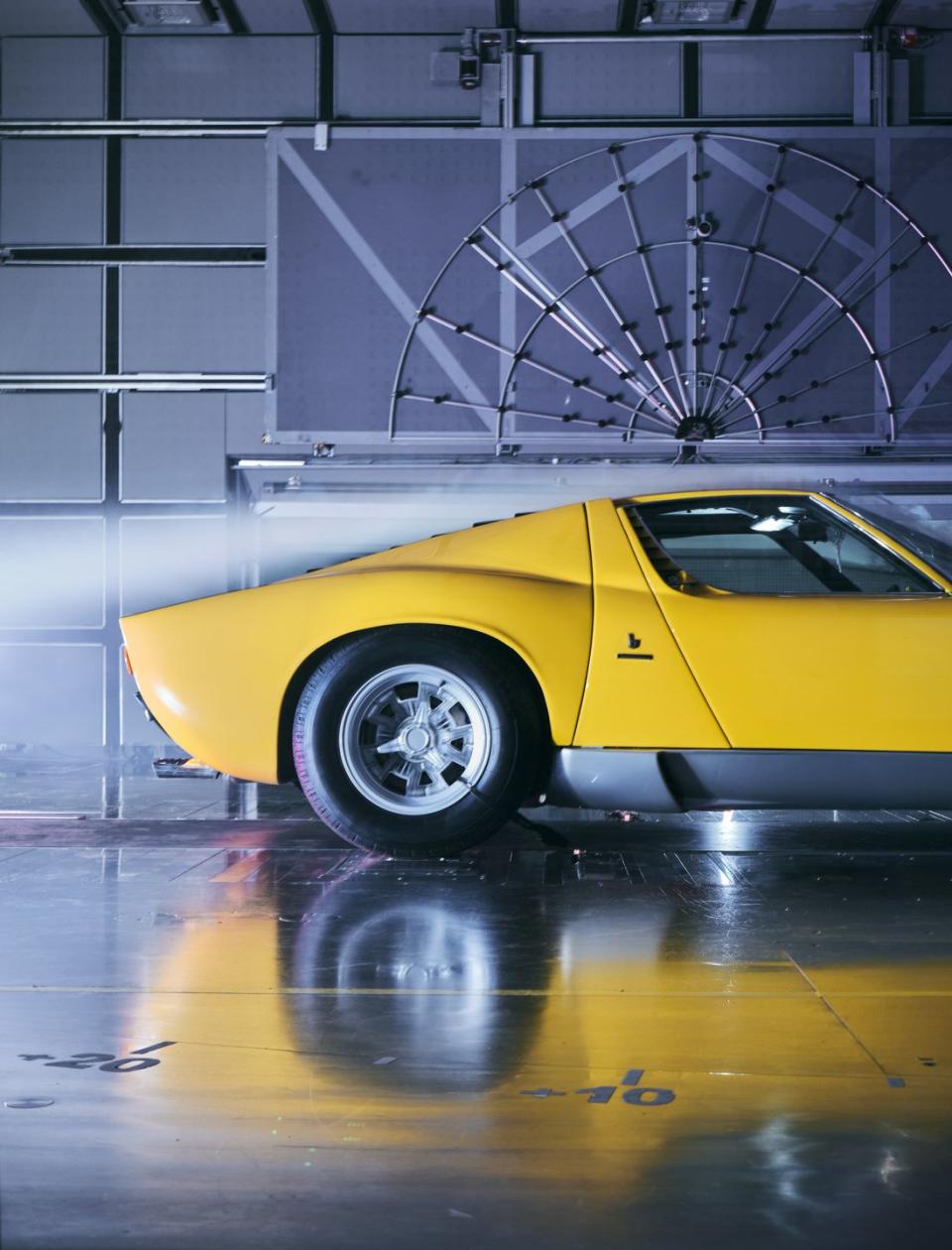
The wind tunnel also reveals a general pattern that the Miura produces more lift on the front axle than the rear. In some respects, this is a good thing. It means the car will tend toward a stable understeer balance as speeds increase. Nobody except Max Verstappen really wants a super-pointy car above 100 mph, after all. However, the amount of lift produced by the Miura is significant. Downforce? Forget about it. At 90 mph, the front axle has 87.1 pounds of lift and the rear 39.9 pounds. By 150 mph, that’s risen to 241.8 pounds at the front and 110.9 pounds at the rear.
Lamborghini claimed the SV could reach 186 mph upon its launch in 1971. Perhaps it could, assuming the driver didn’t back off at 180 mph, at which point the front axle has 347.9 pounds of lift and the rear 159.6 pounds. As the Miura’s velocity increases, the net load on both axles will decrease. Since tire grip (friction) is proportional to the normal force on the tire at the contact patch, the Miura’s ability to put down power and change direction will also decrease with increasing velocity. Consider that the Miura weighs a claimed 2745 pounds and that its tires were developed in the Sixties. Now imagine a high-speed autostrada journey in the rain.
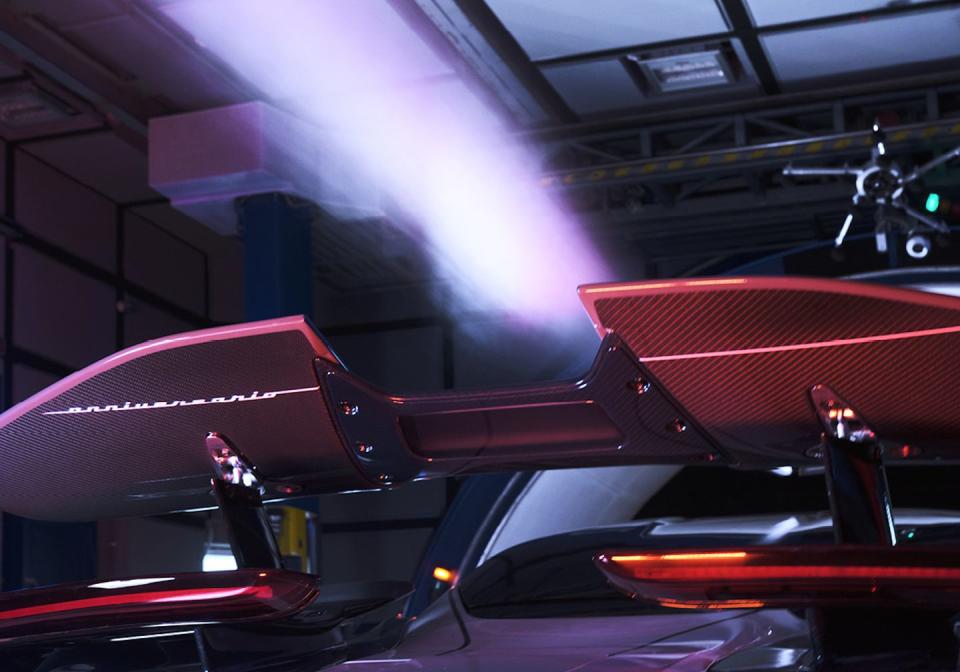
Pininfarina’s wind tunnel has a turntable system, and adding 5 degrees and then 10 degrees of yaw in either direction exacerbates these trends. Not only does the amount of generated lift increase, but the proportion between front and rear lift moves even farther forward. Essentially, a Miura on a sweeping corner generates more lift than on the straight, and its ability to change direction decreases at a higher rate.
There is a fix. Well, at least an easily accessed improvement. Simply turn on the headlights. In their raised position, the lights reduce lift at the front, and the drag penalty is almost irrelevant. Approaching theoretical vMax, the raised headlights reduce front lift by 26.5 pounds with that almost negligible drag penalty. It might be accidental, but this level of aero efficiency is impressive by modern motorsport standards. Sure, it’s tickling the edges of a bigger problem, but should you ever find yourself in fifth gear in a Lamborghini Miura at 7000 rpm, we’d suggest turning on the lights. Where else can you get consumer information of this caliber?
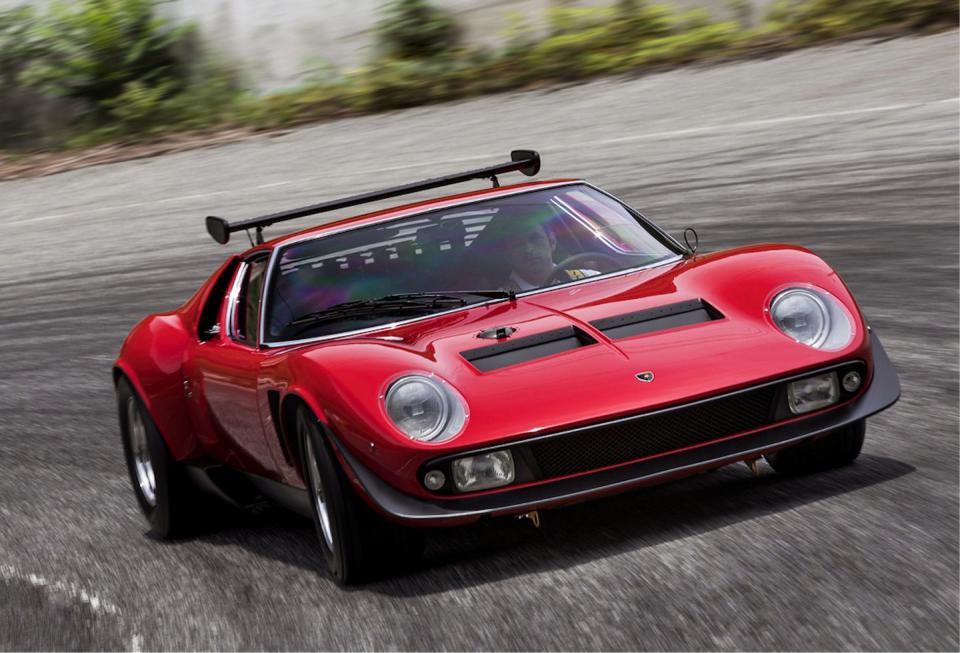
What’s really fascinating is that the wind-tunnel results fall broadly in line with what Lamborghini’s Wallace noticed decades ago.
During a smoke test (where dry ice is used as a visible marker for airflow), one of the aerodynamicists noted a lot of separation where the roof starts to slope downward over the engine cover. “A wing of some sort on the roof there would be really effective,” he said.
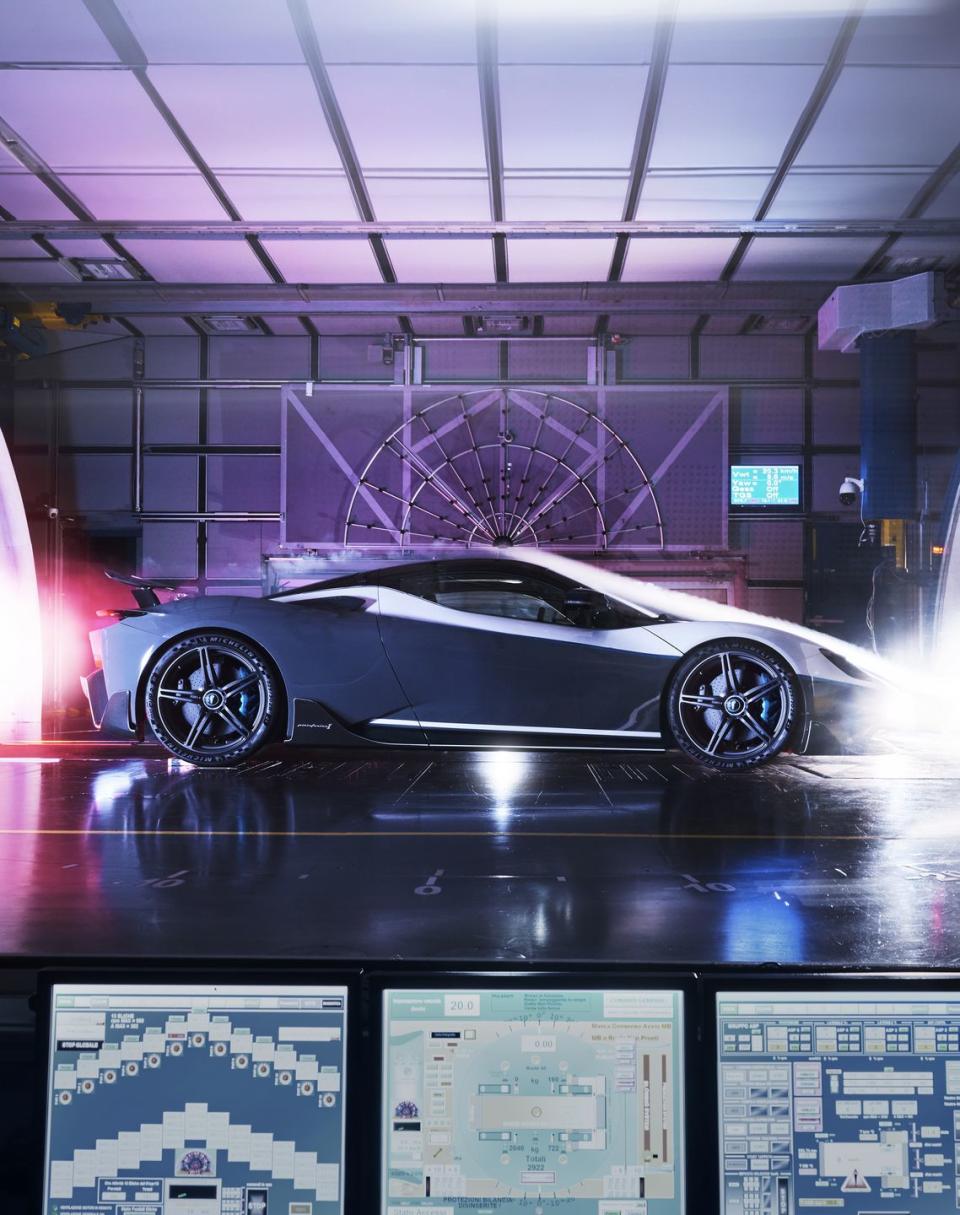
Wallace was always working on ways to go faster. “I had nothing else to do on a Saturday or Sunday anyway, and you had a whole factory to play around with,” he told Hemmings in 2008. So, he experimented with lightweighting using aviation-grade alloys and increased power and body addenda to improve high-speed stability. The result was a one-off, the Miura Jota, featuring a significant chin spoiler and large hood vents to duct air from the radiator and increase aero load. The car was lost in a crash but inspired a handful of Miura SVJs for customers. Then, in 1975, an extremely persistent German customer named Heinz Steber arrived at the factory with his P400S Miura, a set of brakes from a Porsche 917, adjustable Koni dampers, three-piece BBS alloys, a clear vision in his mind, and a large amount of money. Over the next 18 months, Lamborghini created the unique Miura Jota SVR. From 2016 to 2018, Lamborghini’s Polo Storico department restored it, including its large roof wing where the air starts to separate on a Miura SV. It seems Lamborghini’s young engineering minds were good at improvising, even without cold, hard data to work with.
Of course, a wind tunnel or a CFD program would have significantly sped up this process. The Battista program—an ultra-high-performance Hyper GT EV—highlights the new ways but doesn’t abandon old practices entirely. Andrea Crespi, chief technical officer at Automobili Pininfarina, explains: “We wanted a holistic approach. We have four motors to manage with six independent cooling systems, so mass airflow is critical. But aerodynamic balance, for us, was key. Not just downforce.” Clearly, the Battista, even with the Furiosa package comprising an extended front splitter, a more powerful diffuser, and additional turning vanes, is not intended to be a track-focused, Valkyrie-style experience.

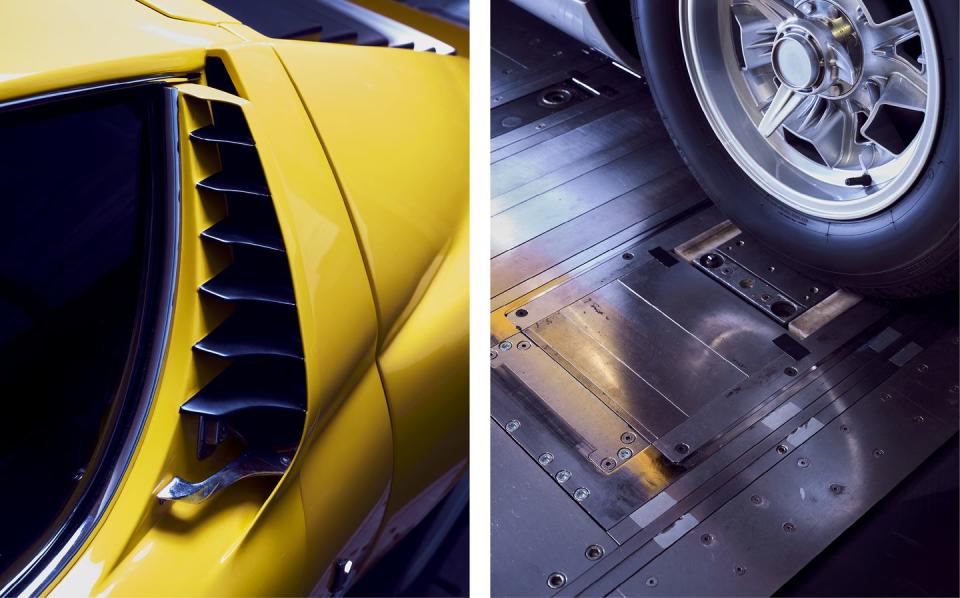
Even so, the transparent quantity of performance causes challenges. “Our car’s transient behavior has to be extremely stable because it can be traveling at 186 mph from rest in 10.5 seconds. In fact, we modeled the Pininfarina Wind Tunnel in our own CFD for correlation and saw less than a three percent difference as a result.” I’m sure Wallace and Dallara in their day would have killed for this capability and the Battista’s active rear wing, which has four set angles and acts as an airbrake at the maximum 35 degrees.
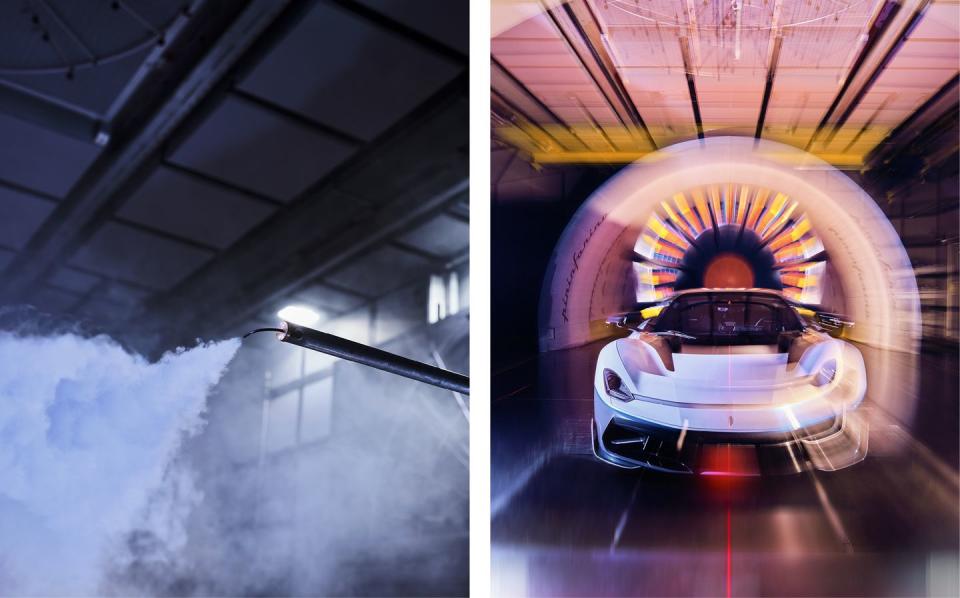
The result is a picture of efficiency and stability compared with the Miura. The Battista has a 0.34 Cd. One key target for Automobili Pininfarina was splitting the vertical load at higher speeds (above 125 mph), 15 percent front and 85 percent rear, which the Anniversario achieves. Apply yaw or even simulated wind gusts, and the aero balance remains stable. At the Battista’s electronically limited 217-mph top speed, it produces 1102 pounds of downforce. Pininfarina’s EV monster might not be designed with pure track performance in mind, but it’s a world away from the Miura. In fact, if a Miura SV could do 217 mph, it would produce 508 pounds of lift at the front axle. Now, imagine the front ride height rising from that force, which would create more lift, even higher ride height, and yet more lift. It’s easy to see how this pattern escalates.
The figures are arresting but can’t tell the whole story. Today, aero performance includes balancing high-speed stability, fuel consumption, and range. Plus, Pininfarina’s tunnel is now used to tune aeroacoustics, which have grown in significance since the emergence of near-silent EVs. However, what’s clear is that aerodynamics inform every decision about a new supercar or hypercar, from conception to final product. It’s incredible to think there was a time when a group of young guys would make a car, throw the most powerful engine they could piece together in the back, and head out to a dimly lit autostrada to see what would happen. It’s an evocative image, but supercar development is about rapid, revolutionary change and using every tool available to enhance performance. Working the air is perhaps the most powerful of them all.
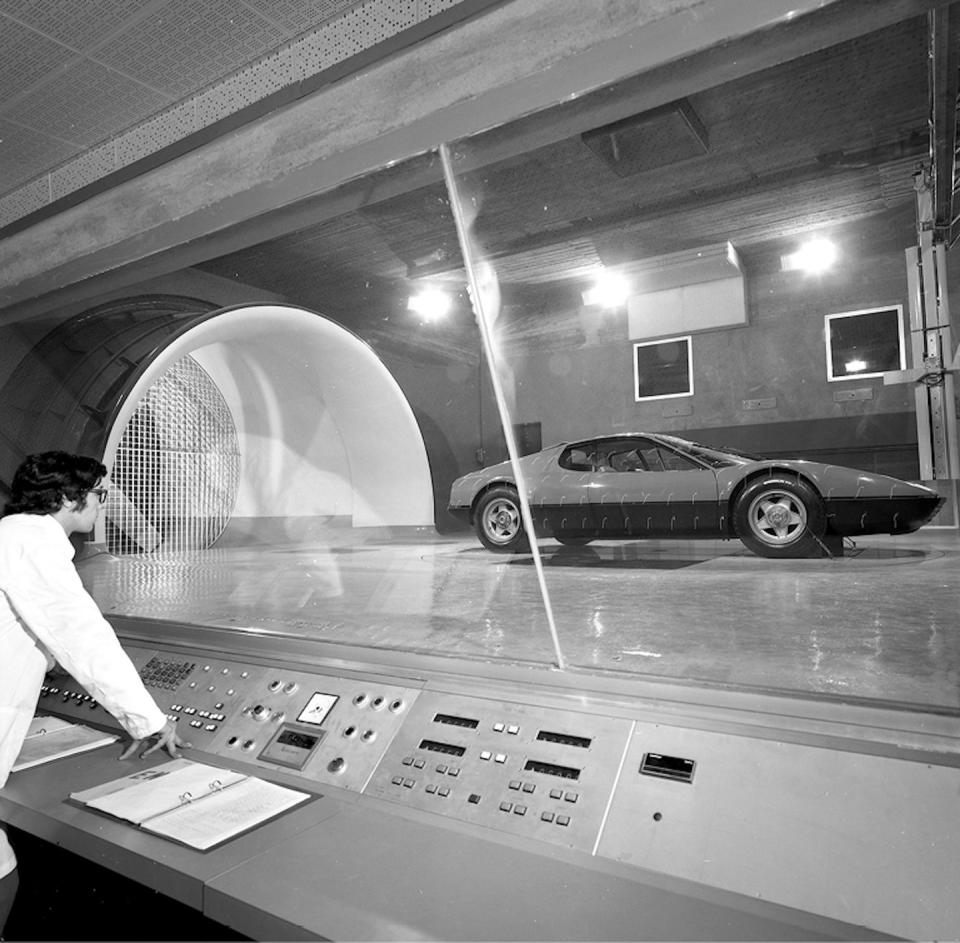
The History of Italy’s First Full-Size Wind Tunnel
When Sergio Pininfarina opened the design firm’s wind tunnel near Turin on June 21, 1972, it was Italy’s first for full-scale cars and one of just seven in the world. Pininfarina, through his work designing and developing Ferraris, could see that having a tool to measure aerodynamic performance would be crucial. The tunnel was an immediate success. It saw the development of Ferrari F1 cars and the Lancia Montecarlo Group 5 cars that won endurance-racing world championships in 1979, ’80, and ’81, as well as road cars, including the Ferrari 365 GT4 BB. It has been upgraded over its half-century of operation and now features a Turbulence Generator System, which can mimic all sorts of conditions, including crosswinds, and helps model behavior during overtaking maneuvers. The tunnel has also been used in the development of sporting equipment, architecture, and high-tech fabrics. And, being from Pininfarina, it looks pretty cool too.

A car-lover’s community for ultimate access & unrivaled experiences.JOIN NOW Hearst Owned
You Might Also Like

 Yahoo Autos
Yahoo Autos 